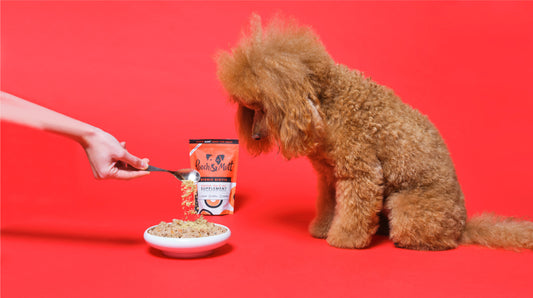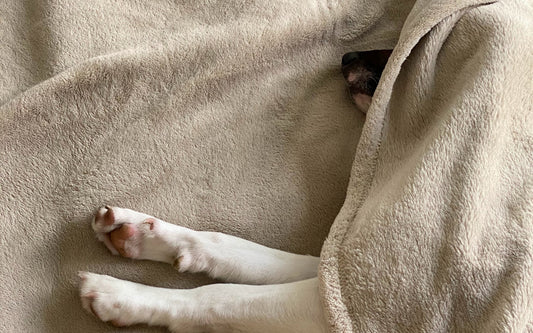Share this Image On Your Site
Please include attribution to https://www.barclondon.com/ with this graphic.
Dog Ear Wax Guide:
- Is it normal for a dog to have earwax?
- How much ear wax should a dog have?
- What should a dog's ear wax look like?
- Should I remove ear wax from a dog's ears?
- What causes excessive ear wax in dogs?
- How can I keep my dog's ears healthy?
Is it normal for a dog to have earwax?
Yes, earwax production is a normal bodily function for dogs and humans alike. Secreted by ear glands, earwax helps to prevent dust, dirt and bacteria from entering the ear and causing infection.
Earwax functions:
- Helps to keep ear canals clean
- Traps irritants like dirt and debris
- Lubricates and moisturises ear canals
- Antimicrobial substances to prevent infections

How much earwax should a dog have?
While small amounts of earwax is normal for dogs, you should keep an eye out for wax build ups as this could indicate a potential health issue.
Excessive earwax production can quickly result in infections and cause dogs significant pain in their ears.
What should a dog’s earwax look like?
As well as monitoring the amount of earwax in a dog’s ears, it’s also important to consider earwax colour and consistency.
Our dog ear wax colour chart can help you understand which shades indicate good health.
Healthy dog earwax tends to range from pale yellow to light brown, whereas darker colours tend to be associated with infections and should be observed by a veterinarian.
| Yellow | A pale yellow colour indicates normal, healthy ear wax |
| Light Brown | A common ear wax colour for healthy dogs |
| Dark Brown | The colour of discharge often associated with yeast infections |
| Dark Green | Often a sign of bacterial infections. Dark green ear wax tends to be accompanied by foul smells |
| Dark Red | Dark red ear wax is usually caused by blood, commonly seen with ruptured eardrums and infections |
| Grey / Black | Grey to black shades of ear wax indicate dust build ups, dirt, debris and infections |
Should I remove ear wax from a dog's ears?
No. While it’s important to check a dog’s ears regularly, you shouldn’t remove healthy levels of earwax for no reason. Cleaning a dog’s ears too much can cause itching and irritation, which in turn can result in infections.
Dogs that are more prone to ear infections and build ups of earwax may need to have their ears cleaned more regularly, but it’s important to contact a veterinarian before removing a dog’s earwax at home.
What causes excessive earwax in dogs?
There are lots of factors that can cause dogs to experience ear wax build ups. By being aware of the different triggers, you can help keep your dog healthy and lower the risks of infection.
1. Hay Fever & Allergies
Allergies are a common culprit of earwax accumulation in dogs.
When a dog suffers an allergic reaction, their skin barrier breaks down and wax production in the ear canal increases. Bacteria thrives under these conditions, increasing the risk of inflammation and irritation.
If your dog suffers from hay fever, you may find them scratching at their ears excessively. In this situation, it's important to consult a veterinarian and seek ways to reduce their exposure.
2. Ear Mites
Ear mites are contagious parasites that are easily spread among dogs. These mites cause pain and inflammation, and are often associated with a dark red, brown or black shade of earwax.
As with allergies, it's vital to contact a veterinarian as soon as you notice any changes in your dog's earwax. Ear mites aren't always easy to spot, which is why regular wellness checkups can help to keep dogs healthy.
3. Infections
Unfortunately, some dogs are more prone to ear infections than others. If your dog suffers from infections regularly, your veterinarian may recommend them to wear a dog cone to prevent scratching.
A dog earwax colour chart can help to identify healthy earwax, enabling you to spot the signs of potential issues early on.

How can I keep my dog’s ears healthy?
A dog’s ears play a number of important roles in maintaining good health, hearing and balance.
However, the ears are an area of the body that are at risk of developing infections which can cause irritation and pain if left untreated.
Because of this, it’s important to monitor their ears on a weekly basis and incorporate ear cleaning as part of their home grooming routine if necessary.
To keep a dog’s ears healthy, you can:
- Regular bathing with quality dog shampoo
- Check their ears at least once a week
- Avoid over-cleaning their ears
- Contact a veterinarian for ear-cleaning solutions



